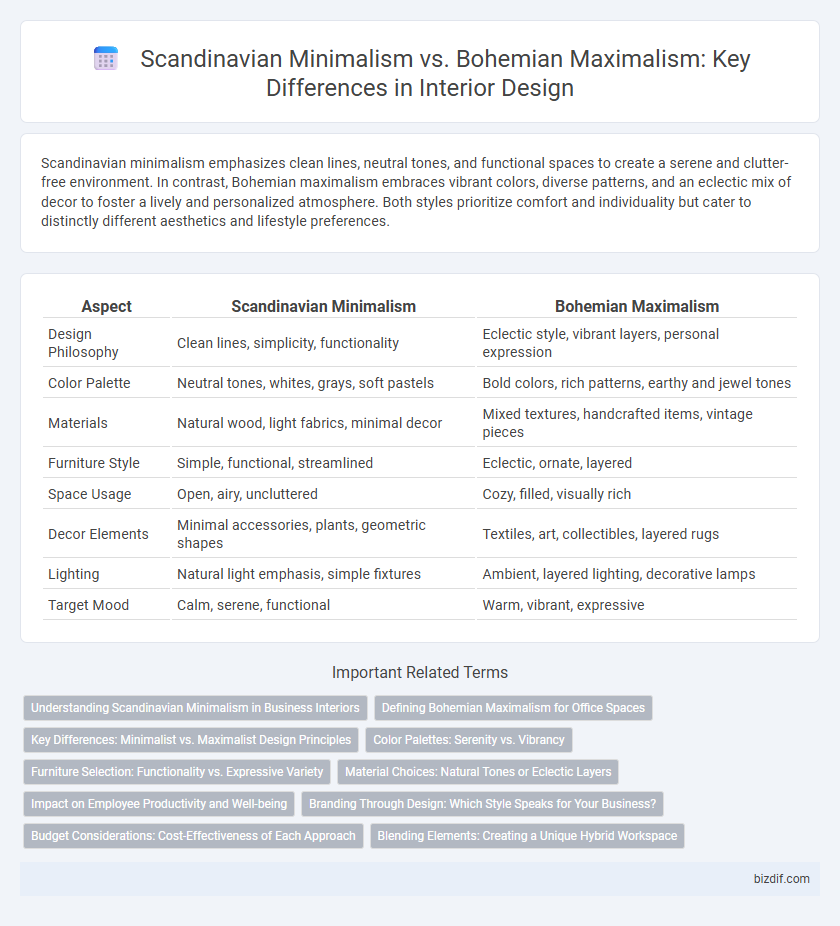Scandinavian minimalism emphasizes clean lines, neutral tones, and functional spaces to create a serene and clutter-free environment. In contrast, Bohemian maximalism embraces vibrant colors, diverse patterns, and an eclectic mix of decor to foster a lively and personalized atmosphere. Both styles prioritize comfort and individuality but cater to distinctly different aesthetics and lifestyle preferences.
Table of Comparison
| Aspect | Scandinavian Minimalism | Bohemian Maximalism |
|---|---|---|
| Design Philosophy | Clean lines, simplicity, functionality | Eclectic style, vibrant layers, personal expression |
| Color Palette | Neutral tones, whites, grays, soft pastels | Bold colors, rich patterns, earthy and jewel tones |
| Materials | Natural wood, light fabrics, minimal decor | Mixed textures, handcrafted items, vintage pieces |
| Furniture Style | Simple, functional, streamlined | Eclectic, ornate, layered |
| Space Usage | Open, airy, uncluttered | Cozy, filled, visually rich |
| Decor Elements | Minimal accessories, plants, geometric shapes | Textiles, art, collectibles, layered rugs |
| Lighting | Natural light emphasis, simple fixtures | Ambient, layered lighting, decorative lamps |
| Target Mood | Calm, serene, functional | Warm, vibrant, expressive |
Understanding Scandinavian Minimalism in Business Interiors
Scandinavian minimalism in business interiors emphasizes clean lines, functional design, and a neutral color palette to create a calming, productive environment that enhances focus and efficiency. Key elements include natural materials like wood, simple furniture, and ample natural light, promoting sustainability and well-being. This style contrasts sharply with Bohemian maximalism, which favors eclectic, vibrant decor and layered textures, often causing visual clutter in professional settings.
Defining Bohemian Maximalism for Office Spaces
Bohemian maximalism in office spaces embraces eclectic patterns, vibrant colors, and layered textures to create a creative and personalized work environment. This design prioritizes functionality combined with artistic expression, using vintage furniture, bold rugs, and diverse decor elements that inspire innovation and comfort. Unlike Scandinavian minimalism's clean lines and neutral tones, Bohemian maximalism encourages a lively, dynamic atmosphere that fosters collaboration and individuality.
Key Differences: Minimalist vs. Maximalist Design Principles
Scandinavian minimalism emphasizes clean lines, neutral color palettes, and functional simplicity, creating airy, uncluttered spaces focused on light and natural materials like wood and linen. Bohemian maximalism embraces rich textures, vibrant colors, and layered patterns, showcasing eclectic decor and personal mementos to create a warm, expressive environment. The minimalist approach prioritizes intentionality and restraint, while maximalist design encourages abundance and bold visual storytelling.
Color Palettes: Serenity vs. Vibrancy
Scandinavian minimalism embraces a serene color palette dominated by soft whites, muted grays, and earthy pastels, creating a calming, airy atmosphere. Bohemian maximalism, in contrast, thrives on vibrant hues such as rich jewel tones, deep reds, and eclectic patterns that energize and personalize spaces. These distinct palettes not only define each style's aesthetic but also influence the emotional experience within interior environments.
Furniture Selection: Functionality vs. Expressive Variety
Scandinavian minimalism emphasizes furniture selection that prioritizes functionality, clean lines, and natural materials such as light wood and muted fabrics to create an uncluttered, serene environment. In contrast, Bohemian maximalism favors an expressive variety of eclectic furniture, mixing vibrant patterns, rich textures, and diverse materials that reflect personal stories and cultural influences. The functional simplicity of Scandinavian pieces contrasts with the bold, layered, and decorative nature of Bohemian interiors, defining their unique approaches to living space design.
Material Choices: Natural Tones or Eclectic Layers
Scandinavian minimalism emphasizes natural materials such as light woods, wool, and linen in neutral tones to create serene, airy spaces. Bohemian maximalism incorporates a vibrant mix of textures and materials like rattan, velvet, and woven fabrics layered with colorful patterns to evoke warmth and creativity. The contrast between the two styles centers on simplicity and uniformity versus eclectic, tactile richness in material choices.
Impact on Employee Productivity and Well-being
Scandinavian minimalism, characterized by clean lines, neutral colors, and uncluttered spaces, enhances employee productivity by reducing distractions and promoting a calm, focused environment. In contrast, Bohemian maximalism, with its vibrant colors, eclectic furnishings, and layered textures, fosters creativity and emotional well-being by stimulating visual interest and personal expression. Balancing these styles can optimize workplace atmosphere, improving both concentration and employee satisfaction.
Branding Through Design: Which Style Speaks for Your Business?
Scandinavian minimalism emphasizes clean lines, neutral palettes, and functional simplicity, projecting a brand image of clarity, efficiency, and modern professionalism. Bohemian maximalism embraces vibrant colors, eclectic patterns, and layered textures, reflecting a brand identity rooted in creativity, individuality, and cultural richness. Choosing between these styles hinges on the business's core values and the emotional connection it aims to establish with its target audience through interior design branding.
Budget Considerations: Cost-Effectiveness of Each Approach
Scandinavian minimalism emphasizes clean lines and functional furniture, often using affordable materials like pine and birch, making it a cost-effective choice for budget-conscious homeowners. Bohemian maximalism involves layering vibrant textiles, eclectic decor, and unique vintage pieces, which can lead to higher expenses due to the diverse sourcing and customization. Budget considerations should weigh the long-term investment in timeless, durable Scandinavian pieces against the potentially fluctuating costs of acquiring diverse Bohemian elements.
Blending Elements: Creating a Unique Hybrid Workspace
Scandinavian minimalism emphasizes clean lines, neutral palettes, and functional simplicity, while Bohemian maximalism embraces vibrant colors, eclectic patterns, and layered textures. Blending these styles in a hybrid workspace involves balancing minimalistic furniture with bold, artistic decor and natural, organic elements to foster creativity and tranquility. Integrating modular storage solutions alongside colorful textiles and plants creates a personalized environment that enhances productivity and comfort.
Scandinavian minimalism vs Bohemian maximalism Infographic

 bizdif.com
bizdif.com